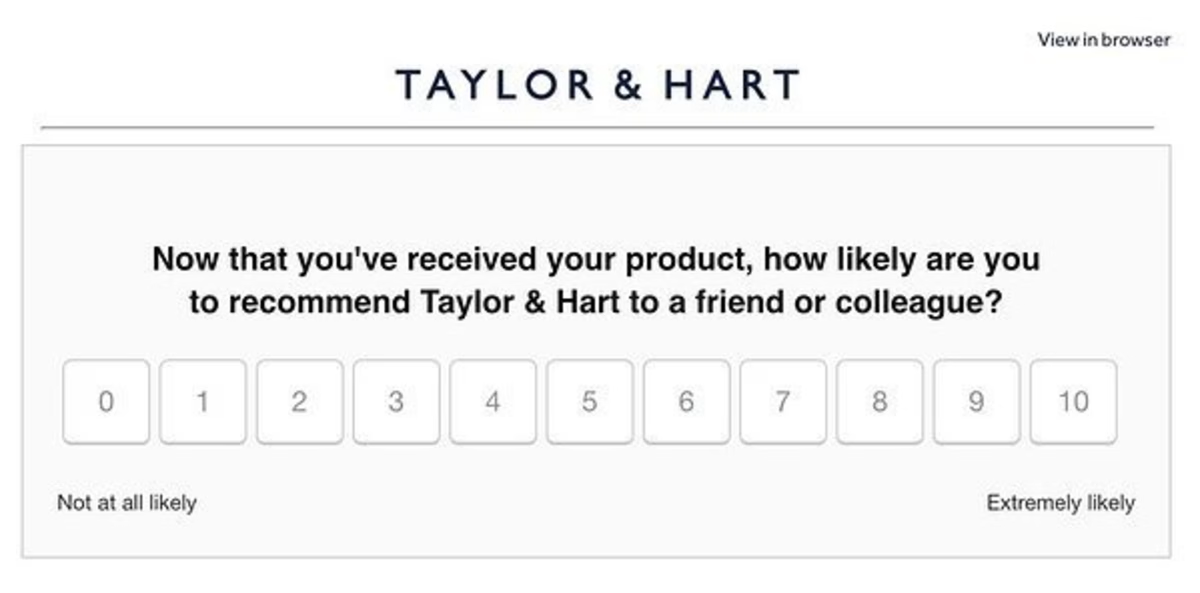The day may come when you feel you’ve hit a wall with your business. Your products are great, and you have an amazing team of talented professionals working with you, but still, you can't seem to grow past your current revenue numbers.
Could it be that you haven't given the customer experience enough attention?
One of the best ways to measure your success in this area is to track Net Promoter® Score (NPS®). NPS® is a crucial business metric that Taylor & Hart, the award-winning jeweler, uses on a constant basis: it's helped them secure repeat business, expand their product offerings, and grow at an impressive pace.
We sat down with Stefan Milev, the company’s CMO, to discuss how Taylor & Hart has grown so quickly by using the NPS® metric and obsessing (in a good way!) over the customer experience.
Taylor & Hart is a London-based jeweler specializing in bespoke engagement rings, uniquely designed and set with ethically sourced diamonds. The company has used NPS® to confirm their growth strategy, transform their manufacturing process, and double their annual revenue.
![[Visual] Taylor & Hart](http://images.ctfassets.net/gwbpo1m641r7/6icMGWEGZOzTIrnuV0uFYl/a9e39078d1c48a847472f86fadd83f1f/Taylor-hart-NPS-consultant.png?w=1920&q=100&fit=fill&fm=avif)
At Taylor & Hart, each customer works with a dedicated consultant to create a bespoke ring
One of their goals while there was to determine the 'One Metric That Matters' to their organization, AKA the one metric they would report on every single day.
They initially thought the ideal metric would be sales. After all, they're in business to make money. But Stefan Milev, the company's CMO, realized that something else was needed to measure and track the customer-centric approach the company wanted to take.
Convinced that you can’t grow revenue without growing NPS®, they settled on NPS® as their core metric. This proved to be a wise decision, as it very quickly became evident that many customers were reluctant to buy a ring from an online-only retailer like Taylor & Hart without seeing it in person first.
By measuring NPS® and ensuring that each of its jewelry consultants focused on exemplary service, Taylor & Hart wanted to turn reluctant visitors into one-time buyers, and one-time buyers into lifelong customers. This customer-centric mindset would, in turn, ensure business growth at an astonishing rate.
![[Visual] NPS 72](http://images.ctfassets.net/gwbpo1m641r7/3dJgRt2xeBZkkzd9KuIARp/4922fd68538b55e540cb8ff54bf98c25/NPS_72.jpg?w=1920&q=100&fit=fill&fm=avif)
You can find your company's score by surveying your customers and asking them the simple NPS® question: "on a scale of 0 to 10, how likely are you to recommend this company/product to a friend or colleague?"
How Taylor & Hart tracks NPS® (and how you can too)
Saying you want to measure NPS® and actually doing it are 2 different things. The team at Taylor & Hart was able to use this metric to their advantage by following a 4-step process.
1. Know your customer experience milestones
As a young company with a relatively tight budget, Taylor & Hart knew early on that they needed to narrow their focus. They identified the 2 main customer milestones that are vital to their business:
The moment a customer places an order
And the moment the order is received
The first milestone is what they call the 'service NPS®', which measures the experience each customer has as they interact with Taylor & Hart's consultants. The second milestone is their 'product NPS®', which tracks customer satisfaction with the final product once it's received.
2. Collect the data you need
Once you understand which milestones to track, you can begin to collect the right data.
At Taylor & Hart, all customers are assigned a dedicated consultant that guides them through the purchase; about an hour after an order is placed, the customer receives the first ‘service NPS®’ email survey.
![[Visual] Taylor NPS](http://images.ctfassets.net/gwbpo1m641r7/1rg8x6QJhbEWMgYGVxa6is/befdfe2b73c69eeef168fcc23e115a52/E-mail20NPS20-2.png?w=1920&q=100&fit=fill&fm=avif)
A Taylor & Hart service NPS® email survey
This email lets the customer rate the level of service up until that point and add comments about it, which in turn tells Taylor & Hart’s consultants what they need to improve or continue doing.
Asking the NPS® question almost immediately after an order is placed means the details are still fresh in each customer’s mind. In turn, the answers allow Taylor & Hart to optimize their processes and improve conversions at the first milestone.
It doesn’t end there. As Stefan explains, the company then sends a product-specific NPS® survey 40 days after purchase, when the ring has been produced, shipped, and received. It usually takes 22 days on average to produce and ship a ring, so they added on some extra days to account for holidays/delivery/etc. “At 40 days, we are absolutely sure the customers have received our rings and can comment on their quality.”

The NPS® question Taylor & Hart send 40 days after the ring has been received
3. Automate your entire process
Taylor & Hart tracks a lot of customer data—possibly more than other, much larger companies. How are they able to do it with their small, 30-person team? By creating automated systems.
Using a combination of Salesforce, Zapier, Wufoo, Google Sheets, and Geckoboard, Taylor & Hart is able to process every piece of customer data and use it to their advantage. Here’s what their process looks like
First, Taylor & Hart's consultants add each customer's details to the company's CRM, Salesforce
When an order is placed, Zapier triggers an email, which is sent to the customer, containing the NPS® question with the 0–10 scoring system
Once a customer clicks a number, they’re taken to a form and asked additional survey questions based upon their initial response (and whether they qualify as a detractor, promoter, or passive)
The customer's answers are then sent to a dedicated Google Sheet via another Zapier trigger. This Google sheet automatically calculates Taylor & Hart's monthly and 90-day NPS®
Finally, the monthly NPS® is displayed on TV screens throughout the Taylor & Hart office. This is done so that the entire organization can see if their customer experience efforts are succeeding or not
![[Visual] Taylor & Hart Office](http://images.ctfassets.net/gwbpo1m641r7/2Qm3NvGwvWVXu9OwVDd3gI/75a6d1f81d41fc76bc2056d2a49e5cee/Taylor-Hart-NPS-office.png?w=1920&q=100&fit=fill&fm=avif)
The office at Taylor & Hart with the TV screen mounted on the right-hand side wall
We have screens above everyone's head that can be easily seen. We have a sales team dashboard which shows your NPS®, revenue, gross profit for the month. We have a marketing one to see the new leads. We have a production one to see how many orders are open, if we have any late ones, ‘what's the product NPS®?’, etc. So, we do dashboards based on the different departments, and every department sees all the dashboards on the screen.
💡 Pro tip: start small by using Contentsquare to send out an NPS® survey to your customers via email, or show them an on-page NPS® survey as they visit your website.
![[Visual] nps-survey-results-Contentsquare](http://images.ctfassets.net/gwbpo1m641r7/695PUA91x9RjSrFEJnn8s4/412d0c29784aa3aaf64fd05c3a548d25/nps-survey-results-Contentsquare.png?w=3840&q=100&fit=fill&fm=avif)
Contentsquare helps you find out how likely your customers are to recommend you, and improve their experience—and your bottom line
4. Track your results
The final step in this process is to track the results.
As Stefan acknowledges, “The first and most important thing is to understand the data, use it as much as you can and connect it to other raw numbers you may find. Once you do that, you start to notice all the patterns, and from there it's actually quite easy to build an actionable plan of what needs to be solved to get your number higher. We pride ourselves on having one of the highest NPS® in the industry: it has been constantly over 80, both for service and product, for over two years now.”
These high scores are possible because Taylor & Hart makes improving their NPS® a top priority. They always know their monthly and quarterly NPS® metrics, as well as the NPS® for each individual consultant on their team. They then discuss and analyze their NPS® findings at each weekly meeting.
By obsessing over their Net Promoter® Score and the customers behind it, Taylor & Hart is able to really understand what their customers want and need, and predict the likelihood of each returning to buy more jewelry in the future.
The benefits of monitoring NPS®
There's no denying that a focus on NPS® has been incredibly beneficial for Taylor & Hart.
For example, analysis of their 2 main NPS® scores revealed that their product NPS® was consistently 10 to 15 points lower than their service NPS®. That could mean customers were more satisfied with the level of care they received during the buying experience than they were with the final product—and that was a problem.
In Stefan’s words, “When someone gives us a low NPS®, it's already too late for us to act. So that's a very, very big issue. We may have the best service, but if the product is not ideal, then that just won't make any sense.” This realization led Taylor & Hart to revamp their entire manufacturing process, including logistics and delivery practices, so that they could create and deliver better products.
Tracking NPS® has also allowed them to spot patterns across popular ring designs, top customer types, and specific geographical areas and optimize their advertising campaigns. “Combining our data, we know, usually with some certainty, what query people used to find us through an organic search; if it's a referral, we know exactly the referrer URL; and so on," he adds. "So every customer, every opportunity we have in our CRM, we know their first contact with the website and where they come from. And then we do reporting based on that, on the average NPS® scores, and average revenue.”
The breakdown and application of this data have resulted in a 70% increase in revenue.
Grow your business by measuring NPS®
By tracking NPS® as their 'One Metric That Matters', Taylor & Hart was able to grow their business at an impressive rate to an annual revenue of €4.5M in 4 years. Which isn't surprising: all great marketing and sales efforts begin with a deep, intimate knowledge of the people a company is selling to.
How can your company leverage NPS® to drive growth? Here’s what we learned from Taylor & Hart’s success:
Make NPS® tracking a priority. Taylor & Hart’s success is deeply tied to their commitment to tracking and improving their NPS®. By pinpointing key milestones in the ecommerce customer journey and measuring satisfaction at each touchpoint, you can identify opportunities to refine your business and boost customer loyalty.
Use automation tools. As your business grows, managing and analyzing customer data manually becomes overwhelming—and valuable insights may slip through the cracks. NPS® survey software helps you efficiently process data and turn it into actionable insights, saving time and maximizing impact.
Treat NPS® as an ongoing effort. Taylor & Hart consistently monitor their score to stay in tune with customer sentiment. This continuous feedback loop allows them to make informed improvements and consistently deliver better customer experiences.
💡 Pro tip: Contentsquare AI for Surveys streamlines the entire process—creating surveys, boosting response rates, and analyzing data with ease. Once responses start rolling in, track your Net Promoter® Score in real time by adding the NPS® widget to your dashboards.
Contentsquare AI then summarizes NPS® responses and open-ended feedback in an auto-generated report, highlighting key findings, customer quotes, and next steps to take.
This feature will come in handy to track your score over time—because the longer you run your NPS survey, the more your response rates grow, giving you richer insights to refine your customer experience.
![[Guide] Surveys AI sentiment analysis](http://images.ctfassets.net/gwbpo1m641r7/36jQmowoqQcZwulSdW26qj/17a48e2b87a9b324d3bda705c2d790ed/Surveys-AI-sentiment-analysis.png?w=1920&q=100&fit=fill&fm=avif)
Contentsquare AI helps you generate surveys in seconds and get an accurate summary of survey responses with a single click
Net Promoter®, NPS®, NPS Prism®, and the NPS-related emoticons are registered trademarks of Bain & Company, Inc., NICE Systems, Inc., and Fred Reichheld. Net Promoter ScoreSM and Net Promoter SystemSM are service marks of Bain & Company, Inc., NICE Systems, Inc., and Fred Reichheld.
![[Stock] Digital intelligence solutions: exploring advanced solutions for businesses — Cover Image](http://images.ctfassets.net/gwbpo1m641r7/3lq9tRa7tIui8K0IO9DmcG/ff563fd0b9cdeb461d91c2a4dbabb18c/digital-intelligence-solutions-woman-tablet-1.jpg?w=3840&q=100&fit=fill&fm=avif)
![[Author] Madalina Pandrea](http://images.ctfassets.net/gwbpo1m641r7/1CsEcp2v6jB6JAqrI9HDBa/76e37b242f67b2f063d657169afc559d/image.png?w=3840&q=100&fit=fill&fm=avif)

![[Visual] Survey questions header](http://images.ctfassets.net/gwbpo1m641r7/OZr2pTCioO2Y5pUHFgtEs/876ee18976b900c04d188396735ac3ca/pexels-alexander-suhorucov-6457488.jpeg?w=1920&q=100&fit=fill&fm=avif)